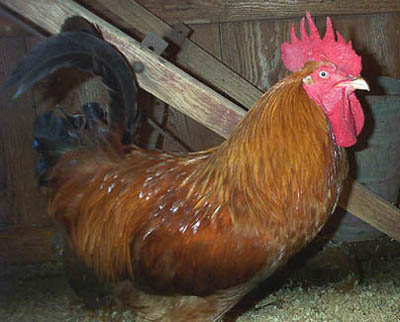New Hampshire Chicken
Category: Standard Chickens

Facts about New Hampshire chickens. Recognized as a heritage poultry breed, the New Hampshire chicken lays large eggs, grows to an average size and serves as a mid-scale meat production to the poultry industry. The New Hampshire chicken is a dual purpose bird and was primarily developed in Rhode Island. Poultry breeders in New Hampshire picked up the New Hampshire chicken for few features that would make the trade more profitable. Some of these features are early feathering, faster growth rate, faster physical maturity, large egg size and more than average meat production.
Most poultry raisers hold a weakness for the New Hampshire Chicken for its ability to survive cold weathers and vigor.
The New Hampshire chicken has a broad and deep body. The males can grow up to 8 pounds (3.6 kg) while the females attain a weight of 6 pounds (2.7 kg) at max. It has a single comb and the single comb, earlobes and the wattles; all are red. Sometimes the comb of the hen may lop over. Its beak is mostly reddish horn colored where as the shanks and toes become yellow. The New Hampshire chicken tail consists of long feathers and is mostly black. The hen’s lower neck feathers may be tipped with black at times.
The New Hampshire chicken is a dual purpose breed. it produces remarkable amount of plump carcass and it lays bigger, brown eggs. As the feathers are reddish, they don’t detract excessively while the New Hampshire chicken gets dressed for sale. Eggs can have different intensity of darkness for few strains. If the New New Hampshire chickens are grown in a well managed environment and given sufficient food, each of them can lay 240 eggs annually, on an average. The female New Hampshire chicken are good mothers.
As the New Hampshire Chicken has a high energy level, it is often found to be indulged in random activities irrespective of size of the place you put it in. It is advised to maintain a lower headcount per square meter for this breed. Food and water should be given in several places at the same time inside the quarters as they are very competitive and aggressive when it comes to obtaining food.
The New Hampshire chicken attains maturity earlier than any other chicken breed. The hens are placid and friendly, hence they are easy to tame while collecting young chicks and eggs. The New Hampshire chicken tend to run away through the passage people enter their quarter. However, as they are not good fliers, don’t need high fencing.

 Back To Category Standard Chickens
Back To Category Standard Chickens